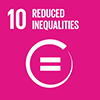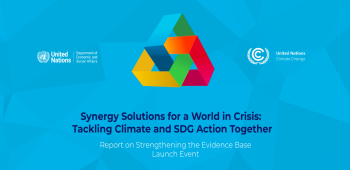Targets and Indicators

10.1
By 2030, progressively achieve and sustain income growth of the bottom 40 per cent of the population at a rate higher than the national average
10.1.1
Growth rates of household expenditure or income per capita among the bottom 40 per cent of the population and the total population

10.2
By 2030, empower and promote the social, economic and political inclusion of all, irrespective of age, sex, disability, race, ethnicity, origin, religion or economic or other status
10.2.1
Proportion of people living below 50 per cent of median income, by sex, age and persons with disabilities

10.3
Ensure equal opportunity and reduce inequalities of outcome, including by eliminating discriminatory laws, policies and practices and promoting appropriate legislation, policies and action in this regard
10.3.1
Proportion of population reporting having personally felt discriminated against or harassed within the previous 12 months on the basis of a ground of discrimination prohibited under international human rights law

10.4
Adopt policies, especially fiscal, wage and social protection policies, and progressively achieve greater equality
10.4.1
Labour share of GDP
10.4.2
Redistributive impact of fiscal policy

10.5
Improve the regulation and monitoring of global financial markets and institutions and strengthen the implementation of such regulations
10.5.1
Financial Soundness Indicators

10.6
Ensure enhanced representation and voice for developing countries in decision-making in global international economic and financial institutions in order to deliver more effective, credible, accountable and legitimate institutions
10.6.1
Proportion of members and voting rights of developing countries in international organizations

10.7
Facilitate orderly, safe, regular and responsible migration and mobility of people, including through the implementation of planned and well-managed migration policies
10.7.1
Recruitment cost borne by employee as a proportion of montlhy income earned in country of destination
10.7.2
Number of countries with migration policies that facilitate orderly, safe, regular and responsible migration and mobility of people
10.7.3
Number of people who died or disappeared in the process of migration towards an international destination
10.7.4
Proportion of the population who are refugees, by country of origin

10.a
Implement the principle of special and differential treatment for developing countries, in particular least developed countries, in accordance with World Trade Organization agreements
10.a.1
Proportion of tariff lines applied to imports from least developed countries and developing countries with zero-tariff

10.b
Encourage official development assistance and financial flows, including foreign direct investment, to States where the need is greatest, in particular least developed countries, African countries, small island developing States and landlocked developing countries, in accordance with their national plans and programmes
10.b.1
Total resource flows for development, by recipient and donor countries and type of flow (e.g. official development assistance, foreign direct investment and other flows)

10.c
By 2030, reduce to less than 3 per cent the transaction costs of migrant remittances and eliminate remittance corridors with costs higher than 5 per cent
10.c.1
Remittance costs as a proportion of the amount remitted
Progress and Info
Incomes of the poorest 40% of the population have generally grown faster than the national average in many countries and financial transfers during the pandemic boosted shared prosperity. However, over the past five years, the gap in per capita income growth between the poorest and richest countries has widened. In addition, discrimination based on age, gender, religion, race, or belief affects one in six people globally. The year 2023 marked a record high of 35.8 million refugees, and over 8,000 migrant deaths were recorded globally. Addressing both within- and between-country inequality necessitates equitable resource distribution, investment in education and skills development, implementation of social protection measures, combating discrimination, supporting marginalized groups, and fostering international cooperation for fair trade and financial systems.
Target 10.1: Among 124 countries with available data, more than half have achieved income growth for the bottom 40% of the population at a rate higher than the national average. However, there are notable regional disparities. In 78% of countries in Northern America and Europe, the bottom 40% experienced faster income growth than the national average, while only 30% of countries in Central Asia and Southern Asia demonstrated this trend. Limited data from the pandemic period suggests that in most regions, financial transfers boosted shared prosperity in many countries by supporting the income growth of disadvantaged populations.
Target 10.3: The number of countries reporting on discrimination has increased by 37% since 2022. However, one person in six continues to encounter discrimination. Racial discrimination and discrimination based on age, gender, religion or belief remain pervasive. While 7% of the population surveyed report being discriminated on the ground of social origin or socio-economic status, only less than a fifth of countries monitor this ground.
Target 10.4: The share of economic output earned by workers decreased from 54.1% in 2004 to 52.7% in 2021, amounting to an average decline of $568 (PPP) per worker. The pandemic exacerbated this situation, with economic output and labour income in 2021 still below 2019 levels in many regions. As earnings from work are crucial for the less well-off and vulnerable, the long-term decline in labour income share represents an upward pressure for inequality.
Target 10.5: In 2022, banks improved their overall performance compared to 2015 amid ongoing COVID-19 recovery. The proportion of countries reporting a return on assets (ROA) above one percent increased to 77.2% from 70% in 2021, with the median ROA rising from 1.34% to 1.56%. Asset quality also improved, with the median nonperforming loans to total loans ratio decreasing from 4.07% in 2021 to 3.52% in 2022. However, the capital buffer remained stable, with the median Tier 1 capital to risk-weighted assets at 16.8% in 2022, compared to 17% in 2021.
Target 10.7: In 2023, there were 8,177 migrant fatalities globally, marking the deadliest year on record, per data from IOM’s Missing Migrants Project. This underscores the urgent need for safe migration pathways, as people continue to risk their lives on irregular routes due to limited alternatives.
Target 10.7: At mid-2023, 35.8 million refugees under UNHCR’s mandate, including other people in need of international protection, remained forcibly displaced due to war, conflict, persecution, human rights violations, and events seriously disturbing public order. This figure represents the highest total recorded to date and reflects increases due to new situations and no progress in resolving protracted refugee situations. In 2015, there were 213 refugees per 100,000 people worldwide, but by mid-2023, this figure doubled to 441 refugees per 100,000 people.
Target 10.c: The global average remittance costs as a proportion of the amount remitted dropped from 7.42% in 2016 to 6.18% in 2023. Corridors offering costs below 5% increased from 23% in 2016 to 75% in 2023. While progress is evident, sustained efforts are needed to meet the target 10.c.





